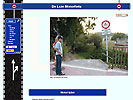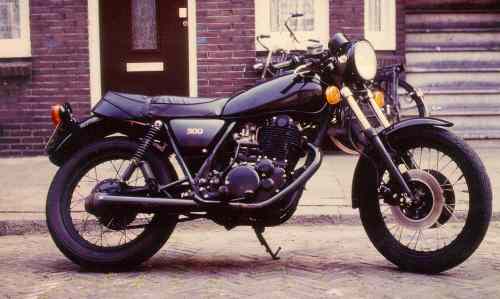
You have passed your exam (in the Netherlands, that is a rather difficult exam: Dutch motorcycle riders are rather well prepared to ride in traffic), and you are ready to buy your first motorcycle.
Which bikes are suitable and which are not? And why? How do you choose your first motorcycle? What are the criteria?
This page tries to formulate some answers.
![]() Er is een Nederlandse versie:
Er is een Nederlandse versie:
https://www.luiemotorfiets.nl/motoren/eerstemotor/
So you passed your exam

So you passed your exam, and now?
When taking lessons and passing an exam is not mandatiry where you live: please take lessons!
After having passed your exam, learning to ride really starts!
When passing your exam, you showed that you are able to perform tight turns and brake exercises, and to ride through traffic with sufficient confidenc and sufficient insight in the traffic.
But there still is much to learn. There are many mistakes of other people in traffic, for instance, for which you should have an answer, and which you should expect, in order to not be taken by suprise.
And your riding technique, in corners for instance, will also increase as the miles or kilometers disappear under the tires of your bike.
There is only one way to learn, and that is: experience. Riding kilometers, and in the mean time trying to be aware how you actually ride.
Born again riders
Born again riders are those that did ride once, a long time ago, and decide to go riding again.
For them, the same applies as for people who just passed their exam.
Your feeling for how a motorcycle works is a bit dusty, and the traffic has changed. You will probably ride safely and happily within a shorter time than completely new riders, but you should understand that you will have to start all over again in certain respects.
Riding lessons
A good advice for people who did ride many years ago, is to take lessons. In many cases you can get a free intake lesson, to decide in which respects you need some guidance and training.
The motorcycle you're dreaming of

Should you buy the motorcycle of your dreams?
Of course, you might long to buy the motorcycle you dream about. A BMW GS Adventure for instance. Or a Yamaha R1 in the colors of Rossi, or a Honda CBR600, or a Harley Davidson StreetRod.
But it is smarter to wait, and start with another bike.
Why not?
The reason not to buy the motorcycle of your dreams is that you make it very difficult for yourself to make progress with your riding technique. When you start jugling, you start with two or three balls, and not with ten, that's how you could see it.
And what if you would go for your dream motorcycle?
When learning to ride a motorcycle, you will have to steer between two kind of dangers:
One danger is that you never feel comfortable on your bike. Corners are fearsome, you never dare to brake hard (even if the motorcycle of your dreams has ABS), with the result that you take your motorcycle less and less on the road, and a year later, your motorcycle might end up on ebay.
The other danger is the opposite: your motorcycle might be so stable, so neutral, that you never notice that something might go wrong, no matter how fast you ride through turns, and no matter how hard you brake. The result might be that on a black day, you ride *too* fast through a corner or you brake *too* hard.
Tight maneuvring
A good test to decide whether a motorcycle is suited for a beginner is: would you be able to perform the figures of eight, the tight circles and U-turns, and the braking exercises that you had to perform on your exam? If not, it is not a good motorcycle to start on.
Won't you be bored soon of a beginners bike?

Won't I get bored?
Even a 250cc motorcycle like a Yamaha Tricker can do 120 kilometers an hour. And if you stand at a red light, most cars will accelerate much less than that small motorcycle.
In other words: it's almost impossible to think of a motorcycle that will bore you because it is too "light".
The other way around is more probable: that you buy a motorcycle which was meant to serve as a temporary bike for a couple of years, to sharpen your feeling for riding, your cornering techniques, your insight in traffic ansd so on, and that you get attached to it much more than you ever thought, and that it is hard to get used to the idea that you will trade it in for the motorcycle of your dreams.
Small is beautiful
What happens often as well is that people buy a heavy motorcycle as their first one, and keep riding on heavy motorcycles, until they get a much lighter bike from their dealer when their own bike is held for service, or when they may ride on a friend's light motorcycle. And from that moment on, they start wondering...
A light motorcycle, both with respect to weight and displacement, has several advantages over heavy bikes. You have more fun, that's what it boils down to.
When you start riding, such a motorcycle for beginners might seem a bike for losers, but when you did ride a motorcycle for years long, you know that it is the opposite way...
What are the requirements for a motorcycle for beginners?

Neutral
In the first place, you'd better start with a motorcycle that does not determine your riding style.
Dreaming of a cruiser
Maybe you always longed for a Harley in your garage, so you would like to start on a cruiser. But you will not know wgat type of riding you like until you have experience riding your first motorcycle.
Maybe you find out that you like riding mountain passes, something for which a cruiser-type motorcycle is not optimal. Of course, it can be the case that you like a motorcycle on which you hardly have to change gears, and on which you gently ride, admiring the landscape around you, and then your next bike will be a cuiser-type one. But you will not know until you know yourself as a motorcycle rider.
On top of that, it is important to learn to brake hard. A cruiser, because of its geometry (there will come a special page on geometry on this site), is inclined to lock the front in case of an emergency brake.
Another weak point of a cruiser is to ride fast corners, and because of the weight, tight turns are often difficult.
Dreaming of a GP machine
Another possibility is that you never miss a GP, and imagine yourself on a very fast motorcycle. But if you really want to learn to race, or just be very fast on the street, it's much better to start riding on a not so fast machine. Racers in the MotoGP for instance, did begin on a 125cc, and most of them started even smaller than that.
Imagine too how it will feel when you, on your "ordinary" beginners motorcycle, will pass people in corners who did begin on their dream-Fireblade or R1.
In short: give yourself the opportunity to find out what you like most about riding, and start on a neutral, "ordinary" bike.
How many cc's?
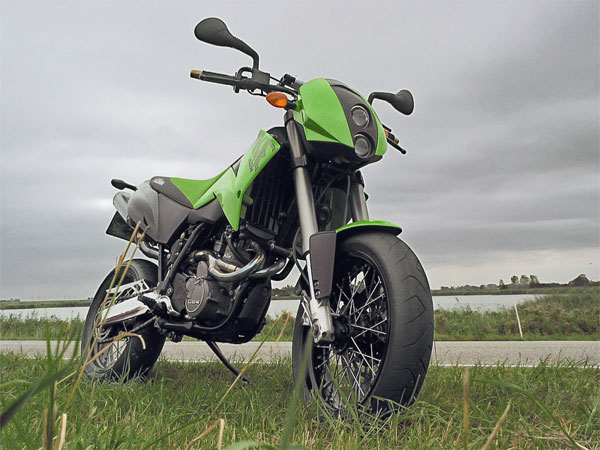
CC's don't tell the whole story
OK, you might think, what is a motorcycle for beginners? One with less than 1000cc? Less than 750cc? Less than 500cc?
The problem is that what makes a motorcycle one for beginners, depends on a lot of factors. So there is no rule that states that a beginners bike is one with less than x cc's or with less power than y.
One thing to remember however, is that 600cc or less will *not* bore you after a while, as many motorcycle salesmen try to tell you.
The KTM Duke for instance, has just about 600cc, but it's a motorcycle that is not suitable for a beginning rider: it's a motorcycle for someone with a lot of riding experience (see the text about the number of cyclinders below).
Tuned back version
In countries where there is a restriction for the amount of Hp a bike may have for certain categories of riders, some motorcycles are tuned back to restrict the power. Think twice before you buy such a motorcycle. In most cases, this is done by narrowing the air intake, or by restricting the amount of throttle that you can give.
Especially when a motorcycle is optimized for power (with high rpm), you end up with a really boring machine on which nothing seems right.
A motorcycle that has less horsepower than such a limit by itself will always give you more fun: it will ride like is was designed to.
How many cylinders?
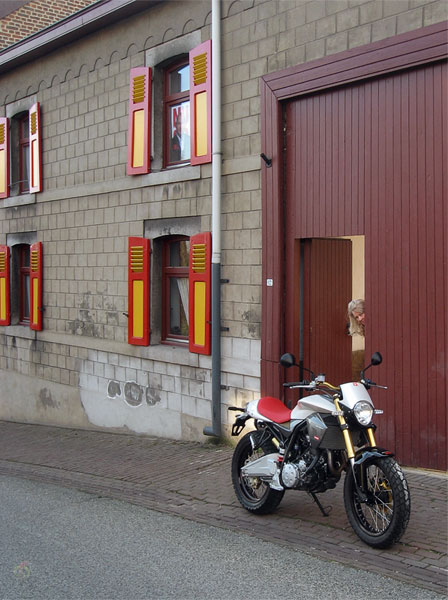
Not a four cylinder
In general, a four cyclinder bike is less suitable for a starting rider. Four cylinders with relatively few capacity (like a CBR600 or an R6) achieve their horsepowers by having their maximum torque at high rpm's (see the page about torque and power).
The cc's are divided over four cylinders. So you can imagine that these four cylinders will move easier up and down at a fast rate than one cylinder with the same amount of cc's.
Therefore, such a four cylinder doesn't have much power in the lower rpm's.
Not a one cylinder
A one cylinder is less suitable in most occasions as well.
The reason is a bit the opposite as in the case of the four cylinders. That one cylinder contains all the cc's. High rpm's are not easy to reach, so most one cylinders have been optimzed to have their maximum torque at relatively low rpm's. A KTM Duke or a Yamaha XT660 for example, are very ready to jump ahead with a bit of gas from standstill. And when you close the throttle, they will brake very hard on the engine as well. When you close the throttle it can really feel as if you stamp on your rear brake; you will be surprized.
So, in short, a one cylinder is often too wild.
Two cylinders
A moderate two cylinder offers the beginning motorcyclist the best of both worlds: even delivery of power, from reasonably low rpm, and no peaky power that is only available at high rpm's.
Not afraid to fall

In the first place, it is important to choose a motorcycle that doesn't make you extra afraid to fall.
That means that you should preferrably buy a second hand bike, that already has some scratches. Another advantage is that you don't have to break in a second hand bike: breaking in can better be done after you have built some feeling for how an engine runs. (there will come a page about breaking in an engine on this site).
Weight
It also means that the weight of a motorcycle is important: don't choose a heavy bike which is hard to handle in tight turns.
Another point is to take a look at what might break during a simple fall when standing still: plastic bodyparts are often very expensive to buy.
Why?
In the first place: almost everyone will drop their first motorcycle once or twice. Simply when parking or when getting on it.
But it is not only during tight turns that a light motorcycle has an advantage; it is
an advantage during a ride as well.
The more relaxed you sit on the bike, the better the bike will behave. When your first
motorcycle intimidates you by its weight or by its awkward handling, it is easy to get
trapped in a downward spiral, where you ride tensly, which results in a bike that
is even more awkward to handle, etc.
Just don't open the throttle?

Bullshit
By telling you "Just don't open the throttle" (in the Netherlands, it's actually "your brains are in your right hand"), salesmen often try to persuade you to buy a much more powerfull motorcycle than you planned to buy, by implying that it would not matter which bike you would buy: riding easy and relaxed would be possible on any bike, they would say.
That's not true: a fast motorcycle is constantly begging you to open the throttle; you will very easily ride much faster than you ever planned to, and when you are able to withold, such a bike is no fun to ride. You will easily end up at a speed at which it is impossible for you to watch the traffic good enough, and to anticipate to mistakes of others.
Sporty four cylinders
Sporty four cylinders such as a CBR600 or Bandit are yearning to be ridden with high rpm's. If you would listen to the motorcycle salesman, and would never open the throttle more than half way, they are like asthmatic donkeys; only when you open the throttle, you will experience what fun they can offer.
So it is a form of masochism to buy such a motorcycle as your first one, and try to be gentle with the throttle.
Low rpm's
So, you should start looking for motorcycles that feel happy at relatively low rpm's. A motorcycle that will not jump aggressively forward with a bit of throttle (at low or at high rpm's), but instead accelerates smooth and linear: just a matter of more throttle, more speed.
The sensation of speed

Objective and subjective speed
Suppose you make a test ride, twice, with the odometer hided. One time you ride a Yamaha R6, and the other time a Royal Enfield Bullet 350. Both times, you try to maintain a speed of about 80 km/h, and there is no other traffic to adjust to.
Probably, your speed on the R6 will be much higher than on the Royal Enfield.
Sensation of speed
So, the sensation of speed differs much between different motorcycles.
A quietly running engine, without much noise or rattlings, prevents you from
feeling speed. A windscreen or a fairing does that too, because you don't feel
the air flow that much. A sharp-steering bike also makes you think your speed
is lower than it is.
The riding position has an influence as well: on a sports bike, you feel comfortable
at a relatively high speed, because the air flow supports you, while your arms and
wrist have to do that at a lower speed.
Because the risk of getting a fine when riding too fast is ever increasing, everybody (not only beginners) do well to choose a bike that gives you the sensation of riding fast at relatively lower speeds.
That means that it is an advantage when your motorcycle is a bit noisy and rattling, if there is some movement in the frame, if he doesn't steer very sharp, and if there is no fairing or windscreen.
Safety
The main advantage of a motorcycle which gives you the feeling of "fast" riding while you ride slower than you would on an R6, is that you have more time to take decisions. On an R6 you easily ride 100 km/h on a main road, before you even notice. That is 7 meters per second faster than 80 (the speed limit in the Netherlands for main roads). The braking distance increases quadratically with an increase of speed...
| Speed in kilometers/hour | Distance in 1 second | Stopping distance | Braking distance (one reaction second included) |
|---|---|---|---|
| 30 km/u | 8 m. | 4 m. | 12 m. |
| 50 km/u | 14 m. | 12 m. | 26 m. |
| 80 km/u | 22 m. | 31 m. | 53 m. |
| 100 km/u | 28 m. | 48 m. | 76 m. |
| 120 km/u | 33 m. | 70 m. | 103 m. |
Note: these are distances, counting with a braking deceleration of 8 m/s2: very hard braking. When you brake "normally", the deceleration is about 5 m/s2. The stopping distance at 100 kilometers an hour is then 77 meters, and when including the second that you need to react, this is 105 meters. So keep practising braking.
On the page about cornering, you can read that it is easier to ride corners when you take your time for the preparation: lowering your speed and shifting.
If speeding is too easy on a bike, you will ride faster, and have less time to prepare
for corners.
The same applies for every decision you have to take: to brake or to swerve,
is there or isn't there room to pass, etc.
The frame not too stiff

Feeling
Maybe this sounds strange for you, but you'd better start on a bike that doesn't steer razor sharp.
Motorcycle riding is a game between the rider and the machine, so you will have to learn to *feel* your motorcycle.
A motorcycle that steers like a razor will be a delight to ride, eventually, when you have learned to feel every subtle sign that your motorcycle may give you. But at the start, you don't feel anything, just because the frame is so stiff and the bike steers that sharp. And when you don't feel anything, you can't learn to feel as well.
A less sharp steering motorcycle might inspire less confidence, in the beginning, but it will allow you to learn to feel exactly what is happening down there, and it will give feedback long, long before anything will go wrong, that you do something that is a bit too much for your bike to handle.
Wobble and dribble
When such a motorcycle starts to feel like a heated chocolate bar in a long corner, it's not too late, so you learn not to get frightened and let your motorcycle find its balance without you interfering.
If on such a motorcycle the rear wheel starts to dribble to the outside, there is no reason to panic at all, and you can learn to keep everything steady, so your bike will find its way.
So, a not very stiff steering motorcycle teaches you to get a feeling for signs that you approach the limit of its capabilities, and teaches you that *not* reacting in panic (closing the throttle, brake), will have the result that the motorcycle finds its balance.
It might sound odd, but a motorcycle is very capable to get itself out of trouble, if only you don't interfere (think, as an illustration, of bikes in races that keep riding after the rider has fallen off).
What about the brakes?

Long fork travel
A light allroad seems to be a perfect beginners bike: they are not optimized for power and ride with energy from low within the rpm's. They are light and agile, and are built to survive a fall without much damage.
But they have a disadvantage: long fork travel, and often soft springs.
The problem is that those ingredients make it easy to lock your front wheel in an emergency brake. When the springs have reached the bottom, every small dip or stone in your line is enough to lock the front, and that's something you don't want in an emergency brake.
ABS?
So, would it be better to choose a motorcycle with ABS?. In that case, there is no risk to lock your front wheel: the ABS will prevent that.
Of course, it's right that ABS prevents a wheel from locking, but there are some hairy details.
In the first place, the ABS sometimes shuts down or doesn't "boot". It happens when the battery doesn't deliver enough voltage, often when it is cold (freezing, with an extra risk for locked wheels because of slippery roads).
Besides that, it is a good thing to learn to brake hard without ABS: otherwise you would be very unsafe on a bike without it.
And at last: ABS only offers extra safety if you ride as though you don't have it (which also
means that you should perform brake exercises now and then, as though you don't have ABS), and that's
very hard for many people.
The idea of safety often makes people rider faster, and closer to the one in front of them then they
would do without ABS, and in that case, you lose all the safety your ABS offers.
So, if you decide for ABS, please teach yourself to brake *well*. Hard, and if possible, with the ABS switched off. And try to ride as though there is no ABS.
What kind of motorcycle?

What do you want to do with it??
Try to imagine what you are going to do with your motorcycle. Are you going to ride a lot through cities? In that case, a light, agile allroad would be perfect, but mind the disadvantage concerning the brakes. An advantage is of course, that you don't have to be afraid of unpaved roads.
Do you want to take your motorcycle on vacations? Then check where and how you can tie your luggage on the bike, and check the saddle: how does it feel after a couple of hours? And check the page about camping.
If your preference is to ride in a racer-like style, don't make the error of thinking that you need a "sport"-model to learn that. On the street, the difference is made in corners, and you don't need a sportsmodel to learn to be fast in corners.
New or second-hand?
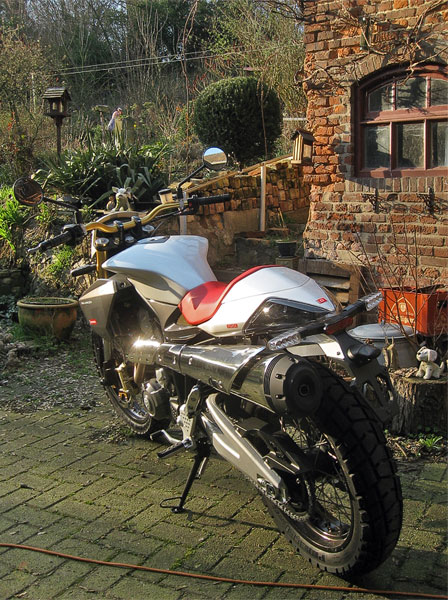
There are a couple of reasons not to buy a new motorcycle as your first one:
- You will have to break in the new engine (see our
page on breaking
in a new motorcycle). Breaking in new engine in is not hard, but it
will cost you attention, and with your first motorcycle, all your
attention should be with the traffic and your riding style during your
first kilometers.
After a couple of years on your first motorcycle, you will be capable to break in your next
motorcycle, if you then decide for a new one.
- In most cases, you will be able to sell a second hand motorcycle after a couple of years for about the same price as what you payed for it, if you maintain the bike regularly. So you will almost ride for free.
- Almost everyone will drop a motorcycle from time to time, especially during the first years. Picking up a shiny new motorcycle, with scratches and all, is not a pleasing activity.
The less frightened you are abour falling, not only doing tight turns but also in sweeping corners, the less stressed and tightly you will sit. When your motorcycle is second-hand and has a few scratches already, that is at least not stressing you extra.
Less is more

Heavy for advanced riders?
When you just got your license, you probably think that motorcycles with lots of cc's (ir cubic inches) are for advanced riders, and that motorcycles with less cc's are in fact a bit inferior.
In reality, almost the opposite is true.
A remarkable number of motorcycles with a displacement between 400 and 600 cc has come to the market during the last couple of years. Motorcycle riders with many kilometers of experience often find out that riding corners on a light bike is more fun than on a heavy bike, that a displacement of 600cc is more than enough to be faster than almost any car, and that you enjoy riding more on such a motorcycle.
Light motorcycles for advanced riders
Increasing numbers of motorcycle riders who own a Pan European or an R1200RT, buy a second motorcycle, and then find out that they leave their heavy motorbike often in the garage.
And the Yamaha Tricker, a 250cc bike, is only bought, remarkably, by motorcycle riders who have many years of motorcycle experience.
Non only a light bike
A light motorcycle (both with respect to weight and with respect to displacement) is not by definition suitable to use as a starter's bike.
You'd better stay off light four cyclinder like the CBR600 or R6, and the same applies for one cylinders with a displacement of 600cc or more (and it even applies for the Yamaha WR450). But what you can learn from this development in the production of motorcycles, is that you certainly don't have to feel inferior with a light motorcycle for beginners.
Example: Suzuki GS500
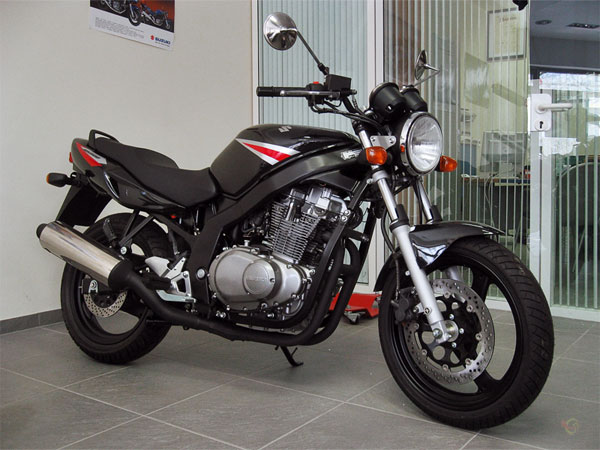
Not for sale everywhere
Mind that this motorcycle and the following bikes have not been imported in every country (in the United States and some other countries for instance, motorcycles of moderate displacement are very rare...). However, I discuss them here, to show which characteristics determine the suitability of a motorcycle for a beginner).
An example of a motorcycle that is a really good beginner's bike, for a couple of years after having passed your exam, is the Suzuki GS500. It comes both with a fairing (GS500F) and without (GS500). The fairing version is still available (see the ) official GS500F page , though not in every country.
Specifications
The GS500 is a two cylinder (twin), and has a weight of about 180 kilograms dry (without oil or fuel). The power is about 50Hp, at 9500 rpm, which is more than sufficient on the street and on highways or interstates. The torque is about 30Nm, at 7500 rpm.
There is a tined back 25Kw (34Hp) version available.
With the GS500 you have a motorcycle that rides easily, in different circumstances, without taking you by surprise. An ideal first motorcycle.
Frame geometry
The GS500 is a really "neutral" motorcycle: the front wheel neither is far forward (cruiser-like), neither very close under the handelbars (like a sports motorcycle). The springs and suspension is neither superb (which would give a narrow band between getting aware that something might go wrong and actually going wrong), neither soft and wobbly and long, like you see in an allroad.
So the GS500 is a motorcycle which will teach you how to brake and how to ride corners in a gentle way. It will always give you feedback about what happens, so you have plenty of time to realise that you ask a bit too much of it.
Example: Yamaha Tricker
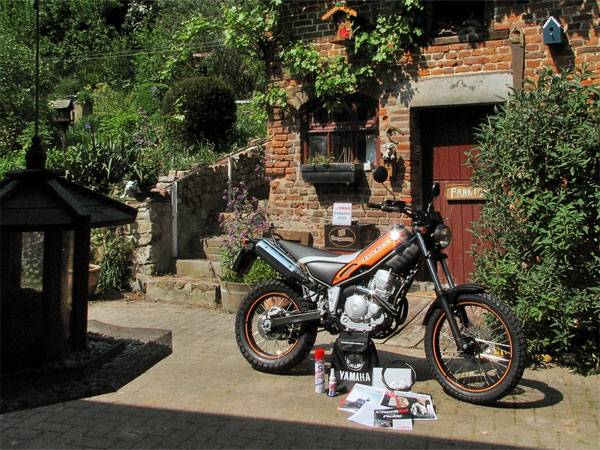
Another example of a first motorcycle is the Yama Tricker. It shows
at the same time that there are no absolute rules for a beginners bike:
it's a one cylinder, and so it is an exception on the rule that in principle,
a beginners bike is a twin.
It is suitable as a first bike because of the tiny displacement of 250cc:
its power delivers really gently, and it won't draw black rubber stripes on
the tarmac when you shift a gear too many back, like it is possible in
bigger one cylinders. The Tricker therefore, is a very sweet and gentle one cylinder.
Unfortunately, it is hard to come by, and not available as new in some countries.
Specifications
Its one cylinder has a displacement of 250cc. Its weight is 118 kilograms dry (without oil or fuel), which is very light. The maximum power is 19Hp (at 7500 rpm). The maximun torque is 19Nm at around 6000 tpm.
The Tricker starts to deliver its power from low in the rpm's. Speeding away from a traffic light will not be a problem: you will keep ahread easily of most cars. Only on the interstates you will feel that it has not enough power: from 100 kilometers an hour on, it is getting asthmetic. It will hardly accelerate anymore.
Frame geometry
The Yamaha Tricker is in fact the only one of its kind. It is a trial motorbike (trialing is climbing over obstacles and jump at low speeds with a motorcycle) that is allowed on the street. The frame geometry looks much as that of an allroad, but the Tricker is even easier to turn tightly, and to raise the front or rear wheel.
The big advantage is its agility, the ease with which you can turn tightly, and the fact that a muddy road is no problem at all, and that it warns you, in long sweeping corners, very early that it's experiencing difficulties, long before something would actually happen.
The brakes
You will have to do brake exercises with the Tricker: it dives into the front springs, and it is difficult to brake really hard. When you replace the rubber brake hoses by steel ones, the brakes will give you more feedbac about what's happening, and hard braking will become easier.
Example: Kawasaki W650

A third example of a motorcycle for beginners is the
Kawasaki W650.
It honours the classic Triumph Bonneville in a beautifull way (after Kawasaki produced
this bike, the new Triumph factory, that is something entirely different than the classic Triumph
factory, came with their own copy of the Triumoh Bonneville, which they named Bonneville
to confuse you...).
For information, look in the German and English enthousiast's groups.
Specifications
The W650 is a two cylinder of 675cc. It reaches its maximum torque of 54Nm at 5500 rpm. Its maxximum power is 47 Hp and it is reached at 7000 rpm. Its weight is 195 kilo (without oil or fuel), which is rather heavy.
All in all, it is a motorcycle of moderate power, which is produced in a gentle way.
This power is enough to be quick enough on interstates, and even on Autobahns, but the W650 is, of course, a motorcycle which feels happiest on rustic roads.
Frame and suspension
The W650 has a really "neutral" frame. You sit upright, the fork travel is moderate, braking is gentle and easy.
This is a great bike for any beginner, and while you're learning to ride, you ride on a motorcycle that looks like a real classic bike.
Example: BMW F650GS

No new motorcycle for beginners
If you check the properties of a good bike for beginners, and you check what motorcycles are for sale now, you will conclude that it is almost impossible to buy a new motorcycle that is suitable to start your riding career on.
Of course, one of the desired properties of a beginners bike is that it is second hand, but even if you disregard that, what's new at the motorcycle dealer is in general too powerfull, too heavy, too etcetera for a beginner.
That's understandable, because any motorcycle that gets the label " beginner's bike" will, in general, be contempted by motorcycle riders, experienced or beginning (though I have the impression that this is not everywhere the case; in the Netherlands, it certainly is).
Dilemma
Therefore, motorcycle manufacturers have a dilemma: beginners are an attractive buyers group, but when a motorcycle is marketed as a good bike for beginners, many motorcycle riders, both beginning and experienced, will hold that bike in contempt.
Verwarring over het type!
N.B. The text below is about the F650GS one cylinder.
The new F650GS is two cylinder bike. We have written a ride report about this new F650GS. The new F650GS comes closer to the ideal beginners bike!
The F650 from BMW has been marketed as a bike for beginners and for women somehow, many people consider those two groups as about one and the same), and in most countries, the F650 never had success.
The F650GS as a beginner's motorcycle
The F650GS is a big one-cyclinder. Not an ideal beginner's bike, but within the motorcycles that you can buy new at a dealer, it is a relatively suitable bike for beginning riders.
That is because the power delivery is smooth. The bike pulls from velow, without bucking at low revs. The F650GS is easy to maneuvre and push into a corner, has a wide steer, and is not too heavy.
Due to its all-road properties, the F650GS dives heavily under hard braking: you'd better buy this bike with ABS, and you should often practise hard braking.
Specifications
The maximum power of the F650GS is 50Hp, at 6500 rpm; the maximum torque
of 60Nm is reached at 5000 rpm. It's weight without fluids ia 176 kg;
with fuel and fluids 192 kg.
The top speed is almost 179 km/h.
F650 and F650GS
Note that when you look for a used F650GS, that there is a big difference between the (older) F650 and the F650GS. The F650 is only manageable from about 4000 rpm; below that number it bucks tremendously.
That is uncomfortable for everyone, for beginners as well.
Experienced riders
Don't be tempted to believe that the F650GS is unsuitable for experienced riders, only because it is a rather sutablebike for beginners: the F650GS is a motorcycle that will please you always, no matter how many miles you have traveled on motorcycle.
You can take it on holidays, fully loaded with tent and other camping gear, it is a very capable Alps conquerer, it has plenty of power for on motorways, and the Eiffel or Ardennes are it's natural habitat.
Comments, Q & A, on a separate page




